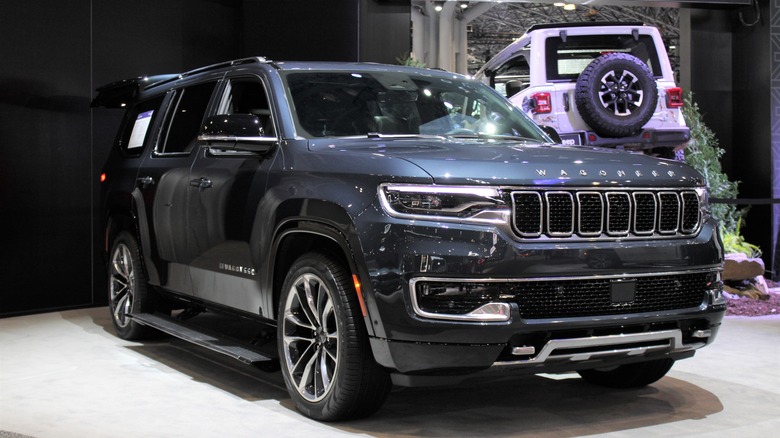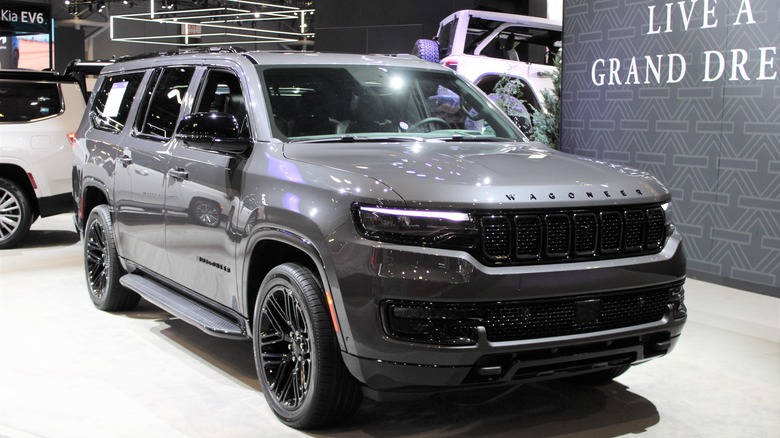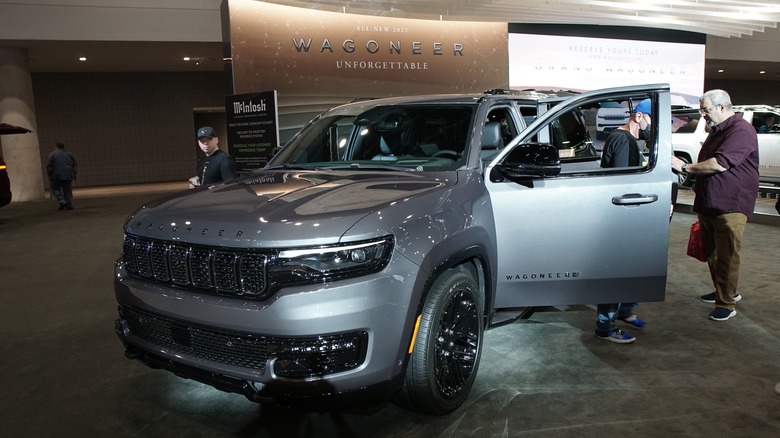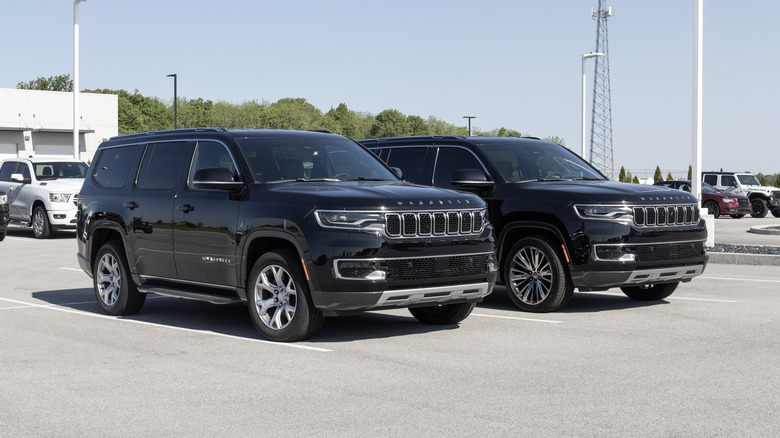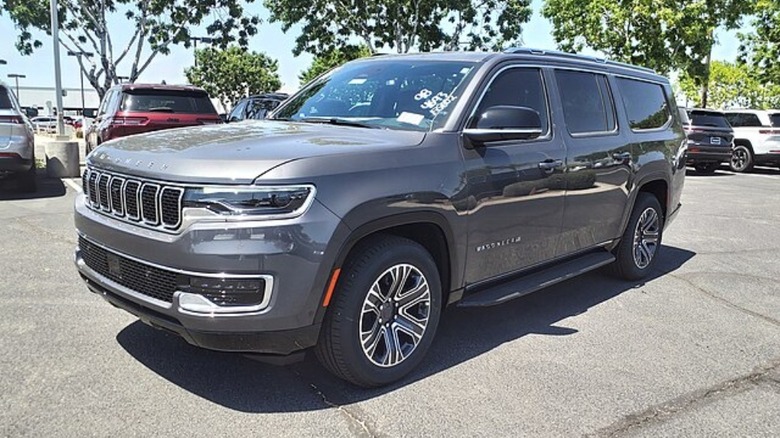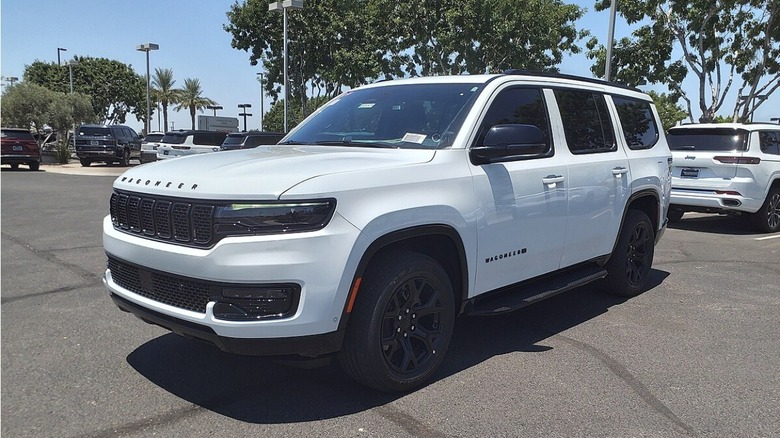2023 Vs 2024 Jeep Wagoneer: What Changes Have Been Made?
The Jeep Wagoneer was first introduced in 1963 in response to competition for the iconic military Willy's Jeep's position as a sizable, practical, hard-working vehicle. The core concept was to move away from the image of the World War II-era vehicle and develop something more stylish and comfortable to compete with the likes of International Harvester's Scout from earlier that decade.
In late 2019, a new concept addition to the Wagoneer family was revealed. The vehicle line returned for the 2022 model year (the line originally ended with the cessation of Grand Wagoneer manufacture in 1991). Still, owners and potential owners of recent models in the Wagoneer line surely want to know if the 2024 model has changed much from its previous guise. With the purchase of a new vehicle being no small financial matter, it's important to determine whether the latest model is worth the upgrade for you and whether it's a worthy purchase over the 2023 model even if you didn't already own one.
To determine whether significant changes have been made for this new Wagoneer, we'll follow up on SlashGear's November 2022 review of the Grand Wagoneer L for the 2023 model years, by taking a look at the specs and features of the 2023 and 2024 models in turn to see how significant the differences between the two model years are. Historically, the vehicle isn't known for dramatic transformations from one year to the next, but we'll see what has been done.
How important is the engine in the 2023 and 2024 Wagoneers?
For many drivers, the most important feature to upgrade in a vehicle is something primal: its power. With the engine being perhaps the single most crucial element of this equation, let's first compare the engines of the 2023 and 2024 models.
2023's Wagoneer is available in four trims: the base model or Series I, Series II, Series III, and Carbide. The base 2023 model offers drivers a choice of the standard 392 HP V8 HEMI or the Wagoneer L's twin-turbo I6, outputting 470 lb-ft of torque (a leap up from the former engine's 404) and offering 420 hp. The I6 is supplied with all other trims. The L model was introduced for 2023, and its increased size translates to approximately 12 inches of extra length overall on the machine's body in both the Wagoneer and Grand Wagoneer, though the Grand L enjoys the 510 hp high-output Hurricane engine.
The 2024 Wagoneer, too, is available in base, Series II, Series III, and Carbine trims. The twin-turbo I6 is equipped as standard in all models, which means that there has been no significant engine change to the Series II and above but that the base model will also benefit from its boosted power and torque. With the Jeep Grand Wagoneer, the situation is the same, with one important distinction: the high-output twin-turbo I6 is now available for all trims, in the standard size.
The features of the 2023 and 2024 Jeep Wagoneer
The 2023 Wagoneer brought tri-zone automatic climate control (similar to that offered by the 2022 Wagoneer, pictured here) a sizable 10.1-inch touchscreen on the dash, and leather-trim seats, with each successive trim option adding to the suite of quality of life, performance, and entertainment enhancements in the vehicle's repertoire. These include windshield wipers that detect and react to rain (Series II), a panoramic sunroof (Carbide), and heated seats in the second row (Series III), rather than just the first as standard. Let's see how the features provided by the different trims of the 2024 Wagoneer compare with those of its previous year's counterpart.
As with the previous model year, second-row seats are heated only in the case of the Series III, and the premium windshield wiper and sunroof options are exclusive to the trim stated (and above) in the case of the 2023 vehicle too. What sets the '24 Wagoneer apart in this regard is the air-sprung suspension, which can be tweaked to provide more room to maneuver, available only on the Series II and Carbide L Wagoneers and the Series III that model year.
In addition, the '24 Series II Wagoneer boasts the choice of the display for the passenger in the front, while the base model doesn't.
A minor boost to fuel economy
Typically, vehicles that boast formidable power and have often had to pay for it in the fuel efficiency department. Stellantis reports, though, that the Hurricane engine exclusively powering 2024's wider Wagoneer family can boast 15% higher fuel efficiency than the sort of engine it replaced.
In January 2021, Forbes reported that SUVs are an average of around 15-30% less efficient fuel-wise than sedans. Both environmental and personal financial concerns, then, will lead potential buyers to another important issue: Is the 2024 Wagoneer more fuel-efficient than the 2023 model?
As we've seen, the V8 HEMI is no longer available for any trim of the 2024 model year Wagoneer. It's the fuel efficiency of the twin-turbo I6 Hurricane that makes the difference when set against the base '23 Wagoneer. That model and its L variant, according to the EPA, have MPG ratings of 16 city and 23 highway, respectively, as a four-wheel drive Hurricane model. It falls to a combined city and highway of 18 (16 and 22 respectively) for its two-wheel-drive counterpart (powered by the HEMI) and 17 for the four-wheel-drive vehicle on midgrade gas. The two-wheel drive '24 Wagoneer, meanwhile, offers city and highway ratings of 17 and 24 respectively on regular gas, 20 combined. Though it's a small increase, there are some areas where slow and steady improvements are the practical ones to implement.
An increased MSRP for the new model year
While various trim levels of new vehicles help drivers ensure they get the vehicles as they want them from the off, they can bring up a dilemma. Do I really need that feature, or will I get good use out of it? The further your trim choice strays from the base model, the higher your price will be, and though the trims and the features they represent are largely the same for the '23 and '24 Wagoneer, the MSRP is slightly higher for the latter model.
The base model of 2023's Wagoneer had a launch price of $58,995, rising to $62,495 for the Wagoneer L edition. The Series II and III trims were priced at $65,080 and $71,220, with an additional $3,000 premium on top if you'd like to opt for the L edition. A four-wheel drive option will also cost another $3,000.
With 2024's model, the same additional costs for the four-wheel drive and L models apply (though the Series III now comes with four-wheel drive capacity), and the price of each trim has increased significantly. At $62,545, the base model now has a slightly higher MSRP than the '23 Wagoneer Series I L, with that L now weighing in at $65,545. For the Series II and III trims, it's $68,340 and $78,840, with the Carbide model coming in between the two at $72,035.
[Image by HJUdall via Wikimedia Commons | Resized /CC0 1.0 Universal Public Domain Dedication]
Determining how the two Wagoneer models stack up
From the very beginning, the Wagoneer marked itself as a more decadent take on the SUV, and made moves towards enhancing that image right from its 1963 model year debut. By 1966, the Super Wagoneer was offering power steering and air conditioning, the forerunners of such features as the customizable climate control of the latest model years' Wagoneers.
A huge, rugged, powerful, stubborn vehicle family, the Wagoneer evolved into the 2023 L models SlashGear deemed "living rooms on wheels" on a First Drive experience in October 2023. The question today has been just how far it evolved from that point. To arrive at a conclusion, we explored each trim of the '23 and '24 Wagoneer, and the features and engine options provided by them. Financial concerns being paramount too, it was crucial to consider the price differences between each trim and tie all of these factors together with the potential difference that trim options and the engine change would make to fuel economy.
With all of these things taken into account, it's evident that 2024's Wagoneer hasn't experienced the most radical changes from the 2023 Jeep, with both years' suites of trim-differentiating features remaining largely the same. The greatest benefit from choosing the new model will seemingly go to those whose Wagoneer previously boasted the Hemi engine, who are sure to appreciate the Hurricane's performance.
[Image by HJUdall via Wikimedia Commons | Resized /CC0 1.0 Universal Public Domain Dedication]
